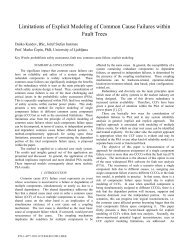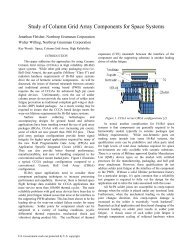Tutorial
Tutorial
Tutorial
You also want an ePaper? Increase the reach of your titles
YUMPU automatically turns print PDFs into web optimized ePapers that Google loves.
time to gather enough data to perform meaningful analysis.<br />
The resulting implementation falls short of everyone’s<br />
expectations.<br />
What caused the problems in these examples? First, the<br />
groups involved did not discuss and prioritize the list of goals<br />
and expectations. Second, there was not objective FRACAS<br />
leadership across the departments. Finally, effective executive<br />
sponsorship verifying and tracking the goals did not exist.<br />
4.4 Solution 2: How to identify and prioritize goals<br />
To overcome the problems caused by a lack of prioritized<br />
goals, several points must be considered while planning the<br />
FRACAS. First, make sure all stakeholders, including<br />
management, discuss and agree on the goals and expectations<br />
of the FRACAS. Objective FRACAS leadership ensures that<br />
all stakeholders’ goals are considered in the planning. Lastly,<br />
determine which goals can be thoroughly accomplished in the<br />
planned FRACAS, and make sure all stakeholders sign off on<br />
the goal prioritization.<br />
4.5 Challenge 3: Ineffective and inefficient data tracking<br />
As mentioned previously, the key to an effective<br />
FRACAS solution is the gathering and reporting of<br />
meaningful data. This seems to suggest that the more data<br />
gathered on an incident or failure, the better the FRACAS will<br />
be. However, this is not necessarily the case. Too much data<br />
may even prevent users from discovering meaningful trends<br />
because they can’t “see the forest through the trees”.<br />
For example, many legacy FRACAS solutions collect 80<br />
or more fields of information when recording a failure.<br />
Although much of this data is valuable, the ramifications of<br />
gathering that much data can result in several problems.<br />
If it takes customer support personnel recording an<br />
incident five seconds to enter data in each field, they will<br />
spend 400 seconds or 6.7 minutes filling out the form for all<br />
80 fields of data, not including any research time. Soon, many<br />
begin to feel that fully logging a problem is just too timeconsuming.<br />
They start routinely skipping fields and not even<br />
reporting some issues at all.<br />
To prevent this, designers develop input screens that will<br />
easily accept incident information. However, they often use<br />
free-flowing text fields to allow customer support personnel to<br />
type any information that they think is useful. The support<br />
users, though, become confused and do not always know what<br />
to enter. Consequently, they begin to include extraneous or<br />
irrelevant data, sometimes just leaving the field blank. The<br />
resulting “data” becomes unable to support any meaningful<br />
analysis and manually scanning incidents for trends becomes a<br />
tedious chore.<br />
4.6 Solution 3: How to effectively manage data<br />
To avoid the problems of inefficient and ineffective data<br />
tracking, organizations will want to establish functional<br />
procedures before data collection begins. Use of simple,<br />
streamlined forms that store data in a central database is often<br />
the best approach. Taking the time to train the FRACAS users<br />
responsible for data entry helps to ensure that all important<br />
data is entered correctly and efficiently. Reminding those<br />
responsible for the failure data entry of the importance of<br />
capturing the data at the time of failure and the long term<br />
benefits to the organization that result from that timely data<br />
capture is critical. Whenever possible, data capture should be<br />
automated as well.<br />
5. STEPS TO SUCCESSFUL FRACAS IMPLEMENTATION<br />
While this tutorial has discussed three of the most<br />
common challenges during FRACAS implementations, the<br />
issues presented are not all-encompassing. Instead, they<br />
outline typical problems that prevent a company, regardless of<br />
industry, from realizing the dramatic results that can be<br />
achieved with a FRACAS.<br />
Few documented tools and techniques exist to aid the<br />
successful implementation of a closed-loop analysis and<br />
corrective action system. This set of steps for successful<br />
FRACAS implementation is intended to help companies<br />
overcome the obstacles outlined above. The eight step<br />
approach is meant as a framework that can be modified as<br />
needed to fit a specific situation.<br />
5.1 Step 1: Define the goals and success factors<br />
Defining the goals of all intended users and stakeholders<br />
is the foundation for a successful FRACAS implementation.<br />
Every step in the process of establishing a FRACAS will be<br />
based upon this definition. A mistake or misunderstanding at<br />
this step can have negative consequences later. Therefore,<br />
implementations require a commitment to thorough research<br />
and documentation is required as otherwise issues may not<br />
come to light until months later.<br />
To begin this process, hold a series of short team<br />
meetings with each of the groups (as identified in Issue 1) and<br />
the representative stakeholders within the FRACAS process.<br />
Using general facilitation techniques, map out specific goals<br />
or expectations of the FRACAS. Typical goals include<br />
lowering maintenance costs, improving overall reliability, and<br />
improving next generation product design. Be careful of the<br />
common pitfall of moving off of goal establishment and into<br />
detailed requirements. The purpose of this exercise is for each<br />
group to reach a consensus on the priority of its main goals.<br />
Once each group has set its primary goals, call a crossfunctional<br />
meeting. One representative from each group and<br />
an executive and/or management representative should attend<br />
to review, consolidate, and prioritize the goals. During this<br />
same meeting, attach what success realistically means for each<br />
of these goals in concrete terms. For example, if a goal is to<br />
lower maintenance costs, a quantifiable success factor may be<br />
to reduce these costs by ten percent over the next 12 months.<br />
At the conclusion of this meeting, each attendee signs a<br />
document that lists the consolidated and prioritized goals<br />
along with their success factors. This single technique will<br />
immediately highlight the level of agreement between the<br />
groups.<br />
Finally, gain executive approval and support and have one<br />
executive take overall ownership and support of the<br />
implementation. Encourage that person to communicate the<br />
4 – Cline & Stillwell 2012 AR&MS <strong>Tutorial</strong> Notes












